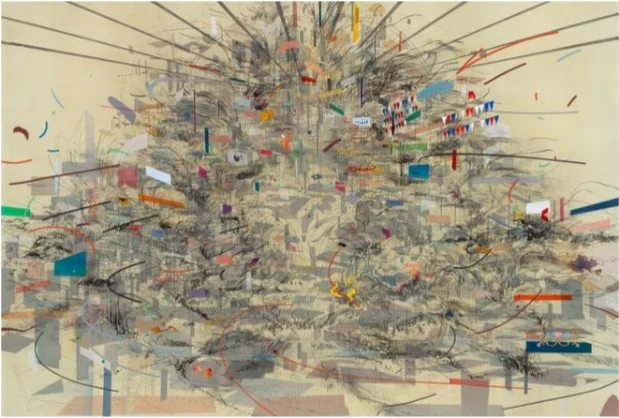Julie Mehretu is an Ethiopian-American visual artist. Born in 1970 in Addis Ababa, Ethiopia, to an Ethiopian university professor and an American school teacher, she is known for multi-layered paintings of abstracted landscapes on a large scale, depicting the effects of urban socio political changes. In 1977 her family moved to the Michigan, USA where her father then found a job as a professor at Michigan State University. Mehretu received a Bachelor of Arts degree from Kalamazoo College in Michigan, did a junior year at Cheikh Anta Diop University in Dakar, Senegal, before moving to the Rhode Island School of Design where she earned a Master of Fine Arts degree in 1997. She currently resides in New York.

Mehretu’s work engages its viewers in a dynamic visual articulation of contemporary experience, a portrayal of social behavior, and the psychogeography of space. The work draws inspiration from a wide range of areas, such as politics, literature, and music. Most recently, her paintings have included photos from broadcast media that show societal unrest, violence, and injustice. These graphic images serve as intellectual and compositional points of departure and remain as a phantom presence in the highly abstracted gestural completed works. Mehretu’s work asserts the role of art in evoking thought and reflection as well as expressing the state of the world today.

Mehretu made Empirical Construction, Istanbul to capture a city which straddles Europe and Asia across the Bosporus Strait. This piece exemplifies Mehretu’s use of layers in a city’s history. The painting-drawing intermixes the city’s past, present, and future and this is shown by Arabic lettering and forms that reference Arabic script scatter around the canvas. Delicate outlines lifted from 360-degree panoramic photographs that Mehretu took of the Old City from the top of the medieval Galata Tower, and from blueprints for the city’s modernisation, appear along with colored planes that evoke urban architectural forms. Angled and arching lines shoot across the canvas away from the center, the point of lowest density, where the ghostly skeleton of the cityscape can be discerned.

This, like other works by Mehretu, foregrounds how new technologies produce images that structure thought. She builds her works by projecting photographs and blueprints. She also produces images made with computer-mapping and graphic-design tools, or the video-game technologies that help to create immersive, fictional world onto prepared canvases. She then traces them, erasing and effacing elements, then adding layer upon layer, each separated by thin coats of acrylic. The resulting works are assertively hybrid, and seem to offer a retrospective perspective, allowing one to look back onto the world from outside, surveying it in all its chaotic motion, fragmentation, and ruin.
Mehretu has received many prestigious awards including the U.S. Department of State Medal of Arts Award in 2015 and membership to the American Academy of Arts and Sciences in 2021. Her work has been exhibited at the Sharjah Biennial in 2015, the Museu de Arte Contemporânea de Serralves in Porto, Portugal in 2017, and at the 58th International Art Exhibition in Venice, Italy in 2019. She was included in The Times’ Most Influential People of 2020.


